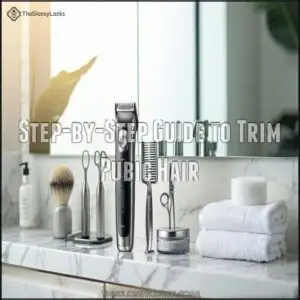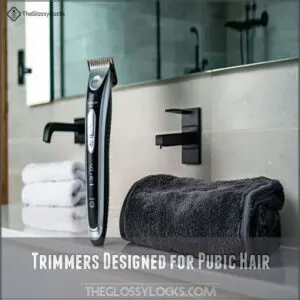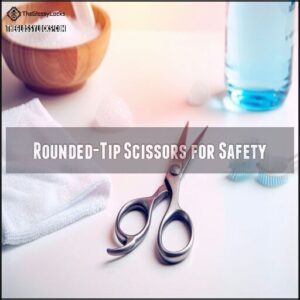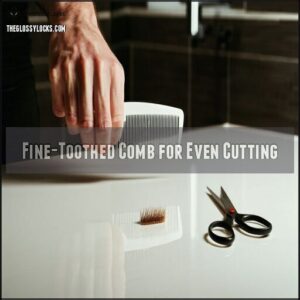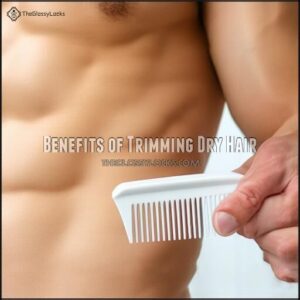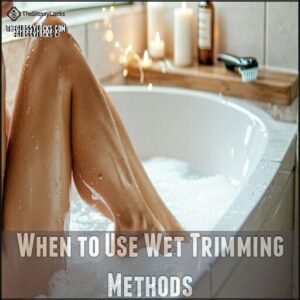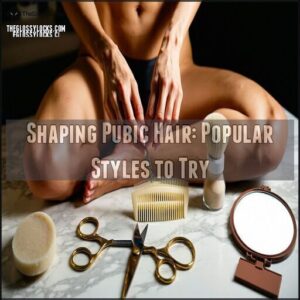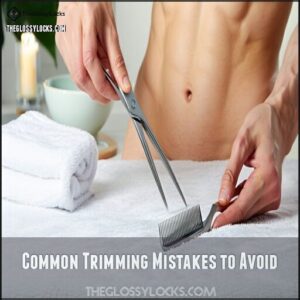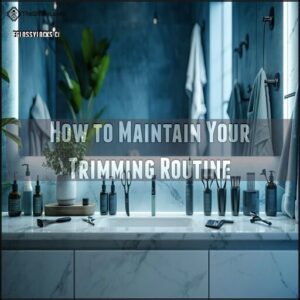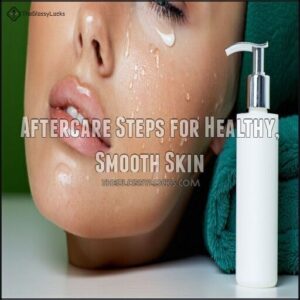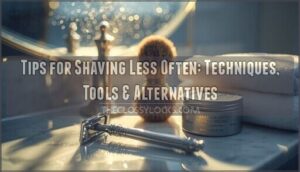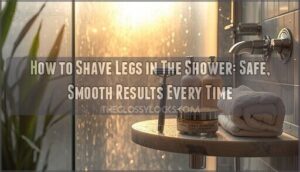This site is supported by our readers. We may earn a commission, at no cost to you, if you purchase through links.
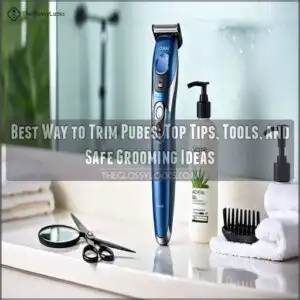 The best way to trim pubes is to start by cleaning the area with a shower, as this softens the hair and reduces bacteria.
The best way to trim pubes is to start by cleaning the area with a shower, as this softens the hair and reduces bacteria.
Use grooming scissors to snip longer hairs first, keeping a safe distance from your skin.
For a neater finish, switch to a body trimmer designed for sensitive areas, ensuring it has a protective guard to prevent nicks.
Work slowly, and use a hand mirror for visibility in tricky spots, stretch the skin gently to avoid cuts.
Always sanitize your tools before and after use, and applying moisturizer or aloe vera after trimming helps soothe the skin.
Table Of Contents
- Key Takeaways
- Step-by-Step Guide to Trim Pubic Hair
- Tools You Need for Effective Trimming
- Should You Trim Pubes Wet or Dry?
- Top 8 Tools and Products for Pubic Hair Care
- 1. Manscaped Lawn Mower 40 Electric Trimmer
- 2. Manscaped Lawn Mower 30 Trimmer Blades
- 3. Philips OneBlade Face Body Trimmer Shaver
- 4. Gillette Sensor2 Plus Disposable Razors
- 5. Schick Sensitive Skin Disposable Razors 24 Count
- 6. Viva Naturals Organic Coconut Oil
- 7. Bevel Pre Shave Oil For Softer Skin
- 8. Neosporin Antibiotic Ointment 24 Hour Protection
- Shaping Pubic Hair: Popular Styles to Try
- Common Trimming Mistakes to Avoid
- How to Maintain Your Trimming Routine
- Hygiene and Safety Practices for Trimming
- Additional Tips for a Smooth Trimming Experience
- Aftercare Steps for Healthy, Smooth Skin
- Frequently Asked Questions (FAQs)
- Are there any health benefits to shaving your pubic hair?
- What are some pubic hair styles for guys?
- Is it normal for a man to shave his pubic hair?
- What is the most efficient way to remove pubic hair?
- Is it better to trim pubic hair wet or dry?
- What is the best way to trim your pubic hair?
- How do most people groom pubic hair?
- Is it healthy to trim pubic hair?
- Is it better to cut pubes wet or dry?
- Where is the best place to cut pubes?
- Conclusion
Key Takeaways
- Start by showering in warm water to clean and soften the area, making the trim easier and reducing irritation.
- Use grooming scissors or a trimmer with a guard to manage length safely, and always sanitize your tools before and after use.
- Stretch your skin gently while trimming to avoid nicks, and use a mirror for visibility in hard-to-reach spots.
- Moisturize with fragrance-free lotion or aloe vera after trimming to soothe the skin and prevent irritation or dryness.
Step-by-Step Guide to Trim Pubic Hair
Trimming pubic hair requires preparation, the right tools, and proper technique to keep your skin safe and irritation-free. Follow these simple steps to groom confidently and maintain hygiene.
Shower First to Clean The Area
Before trimming pubic hair, start with a warm, rejuvenating shower to prime your skin and hair. A quick rinse won’t cut it—take time to soak in water around 95-105°F. This simple step makes a world of difference for pubic area grooming by softening hair, opening pores, and reducing irritation.
Cleanse thoroughly with a mild body wash or an intimate cleanser to avoid irritation and support infection prevention. Lightly exfoliate with a soft cloth to remove dead skin and unclog pores.
- Softening hair guarantees easier trimming or shaving.
- Exfoliating dead skin helps prevent ingrown hairs.
- Clean pores and skin lower risks of infection.
Use Grooming Scissors for Initial Trim
Starting with grooming scissors is the safest way to begin trimming pubes. Rounded-tip scissors work best to avoid accidental nicks, especially in delicate areas. Make sure to disinfect your scissors beforehand—keeping things clean helps avoid irritation later.
Tackle one section of pubic hair at a time. Keep the hair dry, as it’s easier to judge its length this way. Aim for a hair length of around ¼ inch during this initial trim. Using a comb as a guide adds precision: slide the comb under the hair, then carefully cut above the teeth.
A good technique is to gently stretch the skin with your fingers. This makes it easier to see and trim evenly. Take your time—small, controlled snips keep things tidy and manageable.
| Tip | Why It Matters |
|---|---|
| Disinfect scissors | Prevents irritation or infection. |
| Work with dry hair | Easier to judge the length. |
| Use a comb technique | Ensures even cutting. |
| Stretch the skin | Helps avoid accidental cuts. |
| Focus on small sections | Reduces missed spots. |
Switch to a Trimmer for Precision
Once you’ve handled the bulk with scissors, it’s time to bring in precision. A pubic hair trimmer is your go-to tool for smooth, safe results.
Trimmers are designed for comfort as well as minimize the chances of cuts compared to razors.
Here’s why trimmers shine:
- Trimmer Benefits: Adjustable guards allow control over length, so you can refine your look.
- Precision Grooming: Their skin-safe design guarantees accuracy in sensitive areas.
- Avoiding Razors: Less irritation, better for sensitive skin.
Hold your skin taut with one hand, using short, gentle strokes with the other.
Work with a clean trimmer to prevent buildup.
Sharp blades are key to effective pubic hair removal—clean and store it properly post-use.
Tools You Need for Effective Trimming
To trim effectively, you’ll need reliable tools like a dedicated trimmer, rounded-tip scissors, and a fine-toothed comb.
These essentials help you stay safe, achieve precision, and maintain hygiene during grooming.
Trimmers Designed for Pubic Hair
In the context of pubic hair trimming, having a dependable trimmer makes all the difference. A good pubic hair trimmer should prioritize safety, comfort, and performance to handle sensitive areas effectively.
Look for devices designed specifically for this purpose, as they’re built with precision in mind.
Here’s what’s key when choosing the best pubic shaver or electric grooming clippers:
- Trimmer guards – Multiple attachments let you adjust hair length effortlessly.
- Blade material – Hypoallergenic, rounded-tip blades reduce irritation and minimize nicks.
- Motor power – A strong motor guarantees smooth trimming, even for thick hair.
- Ergonomic design – A comfortable grip keeps things steady for seamless use.
- Cordless options – Rechargeable or battery-operated models offer flexibility and ease of use.
Options like the Manscaped Lawn Mower 4.0, Philips OneBlade, and Gillette Intimate Trimmer stand out as top choices for effective pubic hair trimming.
You can find a variety of options online.
Rounded-Tip Scissors for Safety
Rounded-tip scissors are a must-have for trimming pubic hair. These are grooming tools designed with safety in mind, thanks to their rounded ends that reduce the chances of cuts or nicks in sensitive areas. Their stainless-steel blades provide clean cuts, while ergonomic handles make maneuvering techniques simple and steady.
Using them isn’t intimidating—just take your time and keep your hand steady. You can find a variety of rounded tip options online.
Always focus on scissors safety by disinfecting before every use with alcohol or warm soap and water. Pair them with a comb for even trimming. Store your scissors in a clean, dry place to avoid contamination.
A little effort goes a long way in maintaining safe grooming while avoiding cuts and discomfort.
| Feature | Why It Matters | Recommended Practice |
|---|---|---|
| Rounded tips | Prevents injuries | Use for smooth, safe grooming |
| Stainless-steel blade | Ensures durability | Keep blades sharp and clean |
| Ergonomic handles | Aids steady control | Use a controlled, slow motion |
| Compact size | Easy to handle | Store in a hygienic case |
Fine-Toothed Comb for Even Cutting
A fine-toothed comb makes pubic hair grooming precise and safe, ensuring uniform length and minimizing mishaps.
A fine-toothed comb ensures precision and uniformity, making grooming safer and reducing the chance of uneven trims or mishaps.
Use it to guide your trimming tool while protecting your skin. For smoother results, comb flat against the skin and work in manageable sections.
- Choose quality combs for better control.
- Disinfect regularly to maintain comb hygiene.
- Follow hair’s direction to refine technique and reduce irritation.
- Use light, slow strokes for accurate cuts.
- Check progress using a mirror for hard-to-see edges.
Should You Trim Pubes Wet or Dry?
Deciding whether to trim pubic hair wet or dry depends on your grooming method and comfort.
Trimming dry gives you better control, while wet trimming helps with softer hair and reduced irritation.
Benefits of Trimming Dry Hair
Trimming dry pubic hair has its advantages, making grooming more effective and hassle-free. One key benefit is better visibility—dry hair lays naturally, helping you follow the growth pattern for precise trimming.
It’s also easier to manage since the strands don’t stick to your skin like wet ones, reducing the chances of accidental nicks or snags. Another perk? Dry-trimming minimizes tugging, a common cause of irritation or ingrown hairs.
Plus, it’s a quicker process. You can move right into grooming without waiting to soak or dry off. This method also reduces clogging in your trimmer, thanks to dry strands being easier to remove.
For easier management and a polished look, try pre-trim styling with a comb, and keep these grooming tips in mind for safer, smoother pubic hair grooming.
When to Use Wet Trimming Methods
Soft, hydrated skin can transform shaving pubic hair into a breeze, and wet trimming is your best bet for this.
Warm water works wonders for skin sensitivity, hair softening, and razor glide—all essential for a smooth experience with minimal irritation or ingrown hairs.
Here’s how to get it right:
- Start with a warm bath or shower to relax your skin and soften your pubic hair—think of it as priming for success.
- Apply an unscented shaving cream for hydration benefits and visibility.
- Use a sharp razor, shaving gently in the hair’s direction.
- Rinse the blade often to avoid clogging.
- Finish with an alcohol-free moisturizer to soothe sensitive skin and leave it feeling comfortable.
Top 8 Tools and Products for Pubic Hair Care
Choosing the right tools can make pubic hair grooming safer and easier. Here are eight reliable products designed to keep the process smooth and effective.
1. Manscaped Lawn Mower 40 Electric Trimmer
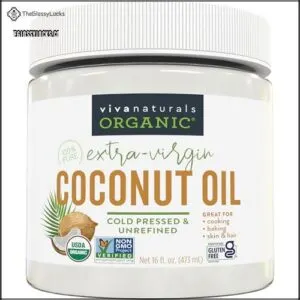
The Manscaped Lawn Mower 4.0 is a superior choice for precise manscaping.
This electric grooming clipper features SkinSafe Technology, which helps reduce nicks and irritation while shaving sensitive areas.
Its waterproof design makes it perfect for trimming pubic hair in the shower, reducing mess.
With an impressive 90-minute battery life, you won’t worry about running out of power mid-groom.
The blade replacement system guarantees consistent performance, and user reviews highlight its reliability for seamless manscaping.
A must-have for effortless pubic hair care!
2. Manscaped Lawn Mower 30 Trimmer Blades
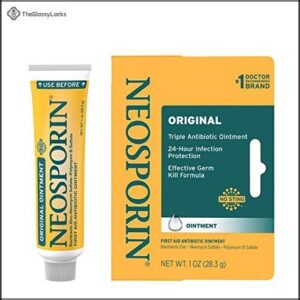
Looking for a smooth trim with zero snags? The Manscaped Lawn Mower 3.0’s replacement trimmer blades are a game-changer for precision, comfort, and safe grooming.
These ceramic blades, designed with SkinSafe Technology, reduce the risk of cuts and irritation, guaranteeing gentle care for sensitive areas.
Combined with its powerful motor, the Manscaped blades handle dense pubic hair effortlessly. Customize your manscaping with adjustable guard options (2-12mm) to shape your pubic hair to perfection.
Plus, the waterproof feature allows trimming in the shower for added convenience, while the LED spotlight guarantees every detail is in sight.
- Ceramic blades for superior skin sensitivity.
- Quiet motor power to tackle thick hair.
- Long battery life for uninterrupted use.
- Guard options provide styling flexibility.
- Trusted for painless manscaping tips.
3. Philips OneBlade Face Body Trimmer Shaver
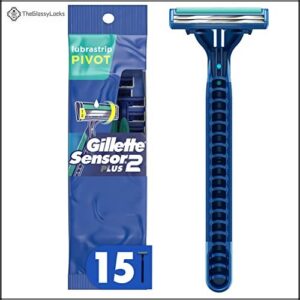
The Philips OneBlade Face Body Trimmer Shaver offers you major advantages for maintaining your pubic hair with precision.
This versatile groomer works perfectly on wet or dry hair, featuring a dual protection system with rounded tips and a glide coating that respects skin sensitivity.
Operating at 12,000 cuts per minute, the OneBlade handles all hair textures efficiently while keeping your delicate areas safe.
The adjustable combs let you experiment with different pubic hair styles, from subtle trims to more defined looks.
Blade replacement is straightforward—simply swap it out every few months for peak performance.
With 60 minutes of cordless run time, you’ll complete your manscaping routine without interruptions.
For wet/dry usage flexibility and body grooming versatility, this trimmer delivers reliable results whether you’re maintaining existing styles or creating new ones.
4. Gillette Sensor2 Plus Disposable Razors
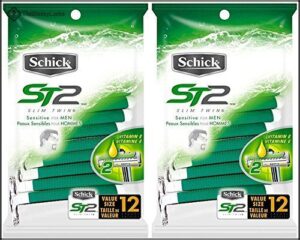
When trimming pubic hair, the Gillette Sensor2 Plus Disposable Razors offer reliable performance for sensitive areas.
These razors combine sharpness with safety for effective grooming.
Here’s why they’re worth considering:
- Twin chromium-coated blades maintain sharpness longer, reducing razor burn risk
- Lubricating strip with vitamin E soothes skin during shaving
- Ergonomic handle provides better control for delicate pubic areas
- Cost-effective disposable convenience compared to electric trimmers
- Compatible with most shaving gels for smoother results
For best results, always trim longer pubic hair before using these razors to prevent clogging and discomfort.
5. Schick Sensitive Skin Disposable Razors 24 Count
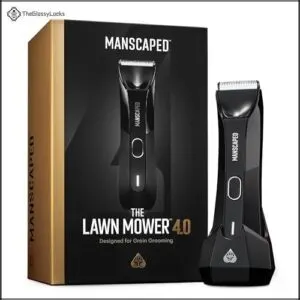
Schick Sensitive Skin Disposable Razors frequently outperform competitors when trimming pubic hair on delicate skin.
These twin-blade razors feature a lubricating Vitamin E strip that helps prevent razor burn while guaranteeing smooth glides over sensitive areas.
The secure grip provides excellent control even at awkward angles.
For best results, pair with shaving cream to maximize skin protection.
| Feature | Benefit | Why It Matters |
|---|---|---|
| Twin Blades | Efficient cutting | Less passes needed |
| Vitamin E Strip | Reduces irritation | Prevents razor burn |
| No-slip Grip | Secure handling | Safer maneuverability |
| 24-Count Pack | Long-lasting supply | Cost-effective shaving |
The generous 24-count package guarantees you’ll never run out mid-trim.
This is particularly important for maintaining smooth glides and ensuring that you have a long-lasting supply of razors, which is cost-effective.
6. Viva Naturals Organic Coconut Oil
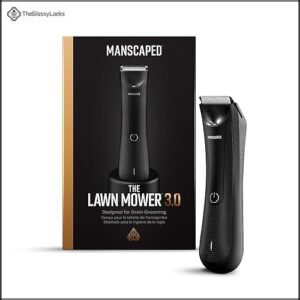
Moving from disposable razors to aftercare solutions, Viva Naturals Organic Coconut Oil serves as a natural multi-purpose product for your pubic hair grooming needs.
This USDA-certified organic oil works effectively before, during, and after trimming to:
- Create a protective barrier that helps your trimmer glide smoothly over sensitive skin
- Reduce post-trim irritation through its natural anti-inflammatory properties
- Moisturize the area deeply, preventing dry skin and itchiness common after grooming
Simply warm a small amount between your fingers and apply to the pubic region before trimming or as a soothing post-trim treatment. The oil absorbs quickly without leaving a greasy residue.
Unlike chemical-laden products, coconut oil’s natural composition makes it gentle enough for sensitive skin while still being effective at preventing ingrown hairs and soothing razor burn. Its antimicrobial properties also help keep the area clean during the healing process.
7. Bevel Pre Shave Oil For Softer Skin
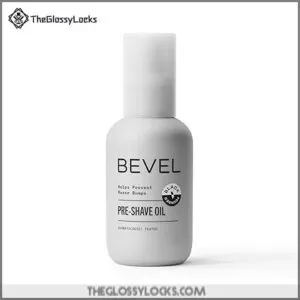
After prepping with coconut oil, consider adding Bevel Pre-Shave Oil to your pubic grooming arsenal.
This premium formula combines castor, olive, and sunflower oils with skin-soothing lavender to create the perfect shaving preparation. The oil benefits are impressive – it softens coarse pubic hair while creating a protective barrier between your skin and razor.
Simply massage 3-4 drops onto damp skin before trimming or shaving for noticeably smoother results. Bevel’s ingredients work together to reduce friction, which means less razor burn and irritation in this sensitive area.
You’ll notice the difference immediately as your trimmer or razor glides more easily. For best results, let the oil sit for 30 seconds before proceeding with your grooming routine.
Your skin will thank you, as the protective barrier helps to minimize irritation, and the skin-soothing lavender calms the skin, ensuring a more comfortable grooming experience.
8. Neosporin Antibiotic Ointment 24 Hour Protection
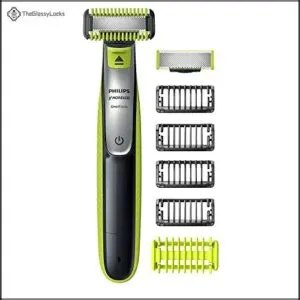
Why is Neosporin Antibiotic Ointment essential for your pubic grooming kit? After trimming your pubic hair, this 24-hour protection formula serves as your skin’s first defense against potential infections from tiny nicks or cuts.
When you trim or shave sensitive areas, your skin becomes vulnerable to bacteria. Neosporin’s triple-antibiotic formula creates a protective barrier while accelerating wound healing in the pubic region.
- Prevents infection by killing harmful bacteria before they cause problems
- Reduces razor burn by soothing irritated skin and calming redness
- Heals ingrown hairs faster by keeping the area clean and promoting recovery
Apply a thin layer to affected areas after trimming, and let it work for 24 hours. For best results, clean the area first and use only a small amount—a little goes a long way. This simple post-trim care step can prevent uncomfortable complications and keep your skin healthy.
Shaping Pubic Hair: Popular Styles to Try
You’ll find several popular pubic hair styles to match your personal preference and comfort level, from a simple even trim to more defined shapes like the landing strip or complete removal.
Your choice of style affects both appearance and maintenance needs, so consider how much time you want to spend on upkeep before selecting your preferred look.
Even Trim for Minimal Maintenance
While most people prefer some pubic hair grooming, an even trim provides the simplest maintenance with maximum comfort.
Set your trimmer to a uniform length (typically 1/4 inch) for quick, hassle-free results. Trim when hair is dry for better visibility and control.
| Tool Maintenance | Trimming Frequency |
|---|---|
| Clean after each use | Every 1-2 weeks |
| Disinfect with alcohol | When feeling uncomfortable |
| Check for rust/damage | Before special occasions |
| Replace blades yearly | When length exceeds 1/2 inch |
Bikini Style for Defined Edges
While minimal maintenance keeps things natural, the bikini style creates that clean, defined look that prevents hair from peeking out of your swimwear.
This popular grooming choice focuses specifically on leg crease shaving and edge definition.
For perfect bikini style grooming:
- Start with a quality trimmer to shorten hair throughout the pubic region to your desired length
- Use depilatory chemicals or a razor to remove hair along swimwear lines completely
- Create smooth transitions between trimmed areas and bare skin for a polished appearance
Pull skin taut while working to avoid nicks and guarantee smooth results. The bikini style requires maintenance every 1-2 weeks as hair regrowth occurs.
After trimming, apply fragrance-free moisturizer to soothe skin and prevent irritation. This approach offers a clean, groomed look without removing all pubic hair – perfect for those wanting definition without complete hair removal.
Landing Strip and Shaped Patch Options
While the bikini style keeps edges neat, landing strips and shaped patches offer more creative pubic hair options.
The landing strip creates a neat vertical line, while other shapes like triangles, hearts, or martini glasses add personality.
Use a trimmer with guard attachments for precision when creating your design. Consider your hair thickness and maintenance frequency—denser hair requires more upkeep.
Partner preferences might influence your shape variety and patch placement.
Brazilian for Complete Removal
The Brazilian method offers a hair-free landscape for those seeking complete pubic smoothness. This removal technique eliminates all hair from the pubic region for a clean appearance.
Benefits of Brazilian waxing versus daily shaving include:
- Longer-lasting results (up to 4-6 weeks)
- Reduced skin irritation over time
- No prickly stubble during regrowth
- Freedom in intimate apparel and swimwear
- Thinner hair regrowth with consistent sessions
For best results, try professional options or at-home kits with proper pain management techniques and regular ingrown prevention care to achieve longer-lasting results and enjoy the benefits of freedom in your choice of clothing.
Common Trimming Mistakes to Avoid
You’ll save yourself pain and potential infection by avoiding these common pubic hair trimming errors that many groomers make.
Using dull blades or dirty tools can lead to nicks, cuts, and skin irritation that turn your grooming session into an uncomfortable experience.
Using Dull or Unsanitized Tools
While exploring popular grooming styles is fun, using proper tools is non-negotiable for safe results.
One serious mistake is neglecting tool quality and cleanliness. Dull razors dramatically increase your risk of cuts, irritation, and painful ingrown hairs. Meanwhile, unsanitized tools introduce bacteria to sensitive areas, potentially causing infections.
To protect yourself:
- Clean all tools with rubbing alcohol before each use
- Store trimmers and scissors in dry, clean containers
- Replace razor blades at first sign of dullness
- Never share pubic grooming tools with others
Sharp, clean tools aren’t just about comfort—they’re your first defense against skin irritation, injuries, and infection risks in your most sensitive areas.
Skipping Initial Hair Trimming Steps
Skipping the initial hair trimming steps is like building a house without a foundation—disaster awaits.
When you jump straight to detailed pubic hair grooming without first trimming longer hairs, you’re setting yourself up for:
- Clogged tools that pull and tug painfully
- Uneven length results that require extra fixing time
- Higher irritation risk from repeated passes over the same area
- Decreased time efficiency as you’ll need to stop and clean equipment
- Style difficulty when trying to achieve precise looks
Your trimmer or clippers need manageable hair lengths to work effectively. Always reduce hair to about 1/4 inch before attempting detailed shaving or grooming. This simple preparation step prevents problems and guarantees smoother results. It is essential to follow this step to avoid clogged tools and ensure a more efficient grooming process, ultimately leading to a better style difficulty when trying to achieve the desired look.
Forgetting Aftercare for Irritation Prevention
After trimming, proper aftercare is just as important as the trim itself. Many people skip this step and suffer the consequences.
To prevent irritation, apply a cool washcloth to soothe freshly trimmed skin, then use a fragrance-free moisturizer to restore your skin’s protective barrier. For itch relief, a small amount of hydrocortisone cream works effectively.
Prevent ingrown hairs with gentle exfoliation after 48 hours. For existing ingrowns, warm compresses provide relief. Using aftershave balm can also provide soothing effects.
Choose loose cotton underwear to let your skin breathe. Tight clothing can cause friction and irritation, setting back your grooming efforts.
How to Maintain Your Trimming Routine
You’ll need to maintain your trimming routine with regular touch-ups every 1-2 weeks to keep your pubic area neat and comfortable.
After each session, apply a gentle, fragrance-free moisturizer to prevent irritation and keep skin healthy.
Regular Trims Every 1-2 Weeks
Your pubic hair grows at its own pace, making regular maintenance essential for comfort and hygiene.
Setting a consistent trimming schedule every 1-2 weeks helps maintain your preferred style while preventing irritation.
Follow these five maintenance tips for ideal pubic grooming:
- Monitor your regrowth speed – most people need touch-ups every 7-10 days
- Check for stubble irritation against underwear – a clear signal it’s trimming time
- Adjust your grooming frequency seasonally – summer often requires more frequent maintenance
- Consider partner preferences when establishing your routine
- Set calendar reminders to maintain style longevity.
The key to successful pubic hair care isn’t just about technique but consistency. A regular schedule prevents overgrowth and keeps your trimmer’s job manageable and effective.
This approach ensures that your pubic hair is always well-maintained, which is crucial for personal hygiene and overall well-being.
Moisturizing After Each Trimming Session
After trimming your pubic area, proper moisturizing becomes essential for healthy skin recovery.
Apply a gentle, fragrance-free moisturizer with soothing ingredients like aloe vera or vitamin E directly to the trimmed region. Look for products specifically formulated for sensitive skin to minimize irritation.
A thin layer is sufficient – don’t oversaturate the area. Wait until skin is completely dry before applying, and avoid products containing alcohol or artificial fragrances.
This simple skin care step prevents uncomfortable dryness, reduces redness, and helps maintain smooth skin between grooming sessions. Consider using products to help prevent razor bumps, which is an important part of post-shave care for achieving and maintaining healthy skin.
Reshaping Styles as Needed
After moisturizing, you’ll want to keep your chosen style looking sharp as regrowth occurs. Your pubic hair grows approximately 0.5mm per day, making style maintenance an ongoing process.
When reshaping your grooming styles, there are several key considerations to keep in mind.
- Examine regrowth patterns before trimming – hair often grows back unevenly
- Use a dedicated pubic hair trimmer with adjustable guards for precise edges
- Maintain symmetry by checking from multiple angles with a good mirror
- Document your preferred style with photos (private ones!) for consistency
Some people adjust their grooming preferences seasonally or for special events. Partner preferences may influence your style evolution too. The key is developing a routine that works with your hair growth pattern and personal comfort level. Regular touch-ups prevent major overhauls and keep your chosen style looking intentional.
Hygiene and Safety Practices for Trimming
You’ll prevent irritation and infection by keeping your trimming tools clean and following proper hygiene practices.
Always disinfect your scissors and trimmers before use, and start with freshly washed and dried pubic hair to guarantee the safest grooming experience, by following these proper hygiene practices.
Disinfecting Scissors and Trimmers
Everyone should properly disinfect their pubic hair tools before each use.
For scissors, soak in rubbing alcohol for 10 minutes or use Barbicide solution. Clean trimmers by removing hair, then spray with disinfectant designed for clippers.
Rinse razor heads with hot water, then soak in hydrogen peroxide. Store attachments in clean, dry containers after disinfection.
Always let tools dry completely to prevent bacteria growth. Disinfecting with tea tree oil provides a natural alternative.
Establish a regular cleaning schedule—ideally before and after each grooming session. These simple hygiene practices substantially reduce infection risk while extending the life of your tools.
Avoiding Cross-Contamination With Tools
 View On Amazon
View On Amazon Now that your tools are clean, let’s talk about keeping them that way. Proper hygiene prevents unwanted infections when grooming your sensitive areas.
- Never share grooming tools with others, even close partners
- Store your pubic hair kit separately from facial or body grooming tools
- Label your separate kits clearly to prevent mix-ups
- Replace blades regularly, as dull blades harbor more bacteria
Washing and Drying The Hair Before Starting
Your body’s cleanliness sets the stage for successful pubic hair trimming. Start with a proper pre-trim cleanse using lukewarm water and mild soap to soften hair follicles.
The process involves several steps, outlined below, to ensure cleanliness and safety.
| Step | Purpose | Duration |
|---|---|---|
| Washing | Remove bacteria | 2-3 minutes |
| Soaking | Soften hair | 5 minutes |
| Drying | Prevent slipping | Until completely dry |
Dry the area thoroughly with a clean towel—damp skin increases your risk of nicks and cuts. This simple preparation makes personal grooming safer and more effective, yielding the best results for intimate hair removal, as clean tools on clean skin is crucial, and remember that proper preparation is key.
Additional Tips for a Smooth Trimming Experience
You’ll find success in your pubic hair grooming routine by mastering a few additional techniques that make the process safer and more effective.
Stretching your skin taut while working, moving slowly to prevent accidents, and using a mirror to see difficult areas will help you achieve the smooth results you want.
Using these techniques will contribute to an overall more effective grooming experience.
Stretch Skin for Better Maneuverability
The pubic hair grooming challenge often includes managing loose skin areas.
Stretching your skin taut is key to smooth, precise grooming and avoiding nicks in sensitive areas.
Stretching your skin taut while trimming creates a smoother surface for safer grooming.
- Hold skin firmly but gently to minimize folds in sensitive areas.
- Pull in the opposite direction of your trimming motion.
- Release and reposition your grip as you move to new areas.
- Focus extra attention on naturally looser skin areas.
This simple technique substantially reduces cut risks while improving precision.
For hard-to-reach spots, try different stretching angles rather than awkward trimmer positions.
Your maneuverability will instantly improve, allowing for more efficient and safer grooming with a simple technique.
Go Slow to Avoid Cuts and Nicks
While stretching skin creates a smoother surface, taking your time prevents painful accidents. Rushing through pubic hair trimming is how most injuries happen.
Patient grooming with steady hands dramatically reduces your risk of cuts. When using sharp blades near sensitive skin, speed is your enemy.
- Feel the weight of the razor in your hand before making any moves
- Listen for the gentle snip of clippers meeting hair, not skin
- Watch as small tufts of hair fall away with each careful stroke
- Notice how your confidence grows with each successful pass
Short, deliberate movements with proper lighting help you avoid nicks. To further minimize irritation, consider the importance of pubic hair purpose. Take breaths between sections and check your progress frequently. Remember: this isn’t a race—your skin will thank you for your caution and patience with proper lighting.
Use a Mirror for Hard-to-See Areas
A mirror serves as an essential ally when maneuvering hard-to-reach areas during pubic hair grooming.
Position a medium-sized mirror on your counter and use a handheld mirror for angle adjustments in those challenging spots.
Good lighting conditions substantially improve visibility, consider mirrors with magnification levels for precision work around sensitive regions.
When trimming with scissors, stretch your skin while maintaining eye contact with the mirror to prevent accidents, for best results use a combination of fixed and handheld mirrors to create multiple viewing angles.
Proper mirror size and placement transform difficult grooming sessions into manageable tasks, ensuring a safe and efficient grooming experience with the right tools and techniques.
Aftercare Steps for Healthy, Smooth Skin
You’ll need to care for your skin after trimming to prevent irritation and maintain smoothness. Apply fragrance-free moisturizer or aloe vera gel to soothe freshly trimmed areas and reduce redness.
Apply Fragrance-Free Moisturizer or Aloe Vera
Your skin’s comfort deserves attention after trimming. Apply a fragrance-free moisturizer or pure aloe vera gel to soothe irritation and reduce redness.
These gentle options promote healing while preventing dryness in your sensitive skin. Products containing vitamin E offer additional irritation reduction benefits.
Simply apply with clean hands using soft, upward strokes, allowing full absorption before dressing. For extra skin hydration, look for natural remedies like coconut oil or shea butter-based moisturizers.
Consider using a quality moisturizer option for best results. This essential aftercare step transforms your grooming routine into self-care, keeping the area comfortable and preventing potential inflammation.
Use Cortisone Cream for Minor Irritation
After moisturizing, you might still experience irritation. Hydrocortisone cream (cortisone) provides quick relief for sensitive skin affected by razor burn.
For effective cortisone application:
- Apply a thin layer to clean, dry areas with mild redness or itching
- Use only once or twice daily for up to a week maximum
- Stop immediately if irritation worsens or skin feels different
This over-the-counter solution reduces inflammation caused by shaving or trimming. While effective for temporary relief, cortisone isn’t for long-term use, as side effects can include thinning skin. For persistent irritation, consider cream alternatives like aloe vera or witch hazel.
Treat Ingrown Hairs With Warm Compresses
While cortisone cream reduces irritation, warm compresses are your best defense against those pesky ingrown hairs that often follow pubic hair removal.
Soak a clean washcloth in warm (not hot) water and apply it to the affected area for 10-15 minutes. The ideal compress temperature softens skin and reduces inflammation, coaxing trapped hairs to surface naturally.
For best results, maintain application frequency of twice daily until the ingrown hair resolves. Follow each compress session with unscented moisturizer as a complementary treatment.
Remember: never pick at ingrown hairs—this simple preventative measure protects your skin’s integrity and is a crucial step in preventing further inflammation and promoting healthy skin with warm compresses.
Frequently Asked Questions (FAQs)
Are there any health benefits to shaving your pubic hair?
Shaving your pubic hair doesn’t offer direct health benefits.
It can reduce odor caused by sweat and bacteria. However, it increases the risk of irritation, ingrown hairs, and cuts, so proceed carefully if shaving.
What are some pubic hair styles for guys?
Imagine tailoring your pubic hair like a sculptor shaping art.
Popular styles for men include the Lion’s Mane, Arrow/Strip, Boy Brief, or all-natural trim—each offering its own balance of style and practicality, with the Lion’s Mane being a notable choice.
Is it normal for a man to shave his pubic hair?
Yes, it’s normal.
Many men shave their pubic hair for hygiene, comfort, or aesthetic reasons.
Personal preference plays a big role, so do what feels right for you.
Just follow safe grooming practices to avoid irritation.
What is the most efficient way to remove pubic hair?
Nearly a quarter of groomers experience injuries, so safety is key.
To efficiently remove pubic hair, trim dry first, then shave wet after soaking.
Use sharp tools, shave gently with hair growth, and moisturize after.
Is it better to trim pubic hair wet or dry?
Trimming pubic hair dry works best for control and visibility, reducing the risk of accidental nicks.
Shave wet after soaking in warm water for 10-15 minutes to soften hair and avoid irritation.
What is the best way to trim your pubic hair?
Start by soaking in warm water to soften skin and hair, then trim dry using sharp, dedicated scissors or a trimmer with a guard.
Always clean tools before use, and shave with the growth direction.
How do most people groom pubic hair?
Most people groom their pubic hair by trimming, shaving, or waxing, often combining methods based on comfort and style.
Preferences vary, but regular trimming and proper hygiene tools help prevent irritation, ingrown hairs, or accidental nicks, which can be mitigated by proper hygiene.
Is it healthy to trim pubic hair?
Think of trimming pubic hair like pruning a plant—it keeps things tidy and healthy.
It’s as well as safe but helps maintain hygiene, reduces sweat buildup, and minimizes irritation.
Just use clean, sharp tools to avoid injury.
Is it better to cut pubes wet or dry?
Cutting pubes dry works best for trimming since it’s easier to manage and see.
For shaving, do it wet—soak in warm water first to soften hair and reduce irritation.
Always prioritize skin safety.
Where is the best place to cut pubes?
Imagine a bird carving its nest—precision matters.
The best place to trim pubes is in a well-lit bathroom.
Stand over a towel, sit on the toilet, or use the shower for easy cleanup.
Conclusion
Did you know that 70% of people prefer trimmed pubic hair for hygiene or comfort?
To achieve the best way to trim pubes, start with clean skin, use sanitized tools, and trim carefully to avoid nicks. Whether you prefer scissors, a trimmer, or a specific style, taking your time is key.
Don’t forget aftercare—apply a soothing moisturizer or aloe vera to maintain smooth skin. With the right steps, grooming can be safe, effective, and simple.

